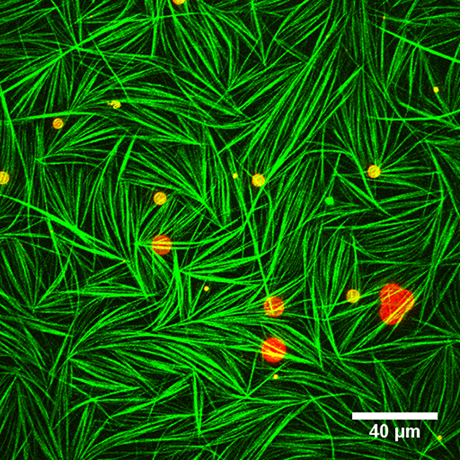Tapping into Marine Biodiversity to Address Questions Not Yet Imagined

 Gladfelter studies the septin proteins and other structures and processes important for cellular organization. Above, recombinantly expressed and purified septins (green) are polymerized on a glass coverslip. Credit: Drew Bridges, Gladfelter lab
Gladfelter studies the septin proteins and other structures and processes important for cellular organization. Above, recombinantly expressed and purified septins (green) are polymerized on a glass coverslip. Credit: Drew Bridges, Gladfelter labThe study of life processes has long depended on a small set of so-called model organisms that are amenable to laboratory manipulation and emerged, whether by reasoned choice or experimental serendipity, as favorites for study by legions of scientists and students. But not by everyone.
As Amy Gladfelter, professor of cell biology at Dartmouth College and a long-time Whitman Center investigator at MBL, argues, the exploration of what she calls “nontraditional model systems” provides critical advantages to uncover and address questions that “we do not even know exist.”
As Gladfelter writes in her essay upon receiving the 2015 Women in Cell Biology Sustained Excellence in Research Award from the American Society of Cell Biology, there are many “truly unknown problems in biology waiting in the wings.” And, she notes, “many of these creatures happen to reside in the sea or other aquatic habitats and boast deep literatures of physiology, behavior, and, in some cases, cell biology … The sea is vast, and we have tapped into an extremely small amount of the diversity.”
 Ashbya, a filamentous fungus and nontraditional model organism studied by the Gladfelter lab. In this image, single cyclin mRNA transcripts are shown in red, nuclei in cyan. Credit: Samantha Roberts, Gladfelter lab
Ashbya, a filamentous fungus and nontraditional model organism studied by the Gladfelter lab. In this image, single cyclin mRNA transcripts are shown in red, nuclei in cyan. Credit: Samantha Roberts, Gladfelter labThe MBL may be the perfect place to pursue such “unknown problems.” As she writes, “the advantages and joys of work in an unchartered [model] system revolve around the intellectual challenges, the breathing room of broad problems, which is especially useful for junior scientists, and the potential to discover truly new solutions in biology and for society. Each summer I move part of my lab to the MBL in Woods Hole, and one future for this hallowed place may well be to facilitate the development of new systems.”
Gladfelter, Amy S. (2015) How nontraditional model systems can save us. Mol. Biol. Cell 26: 3687-3689; doi: 10.1091/mbc.E15-06-0429.